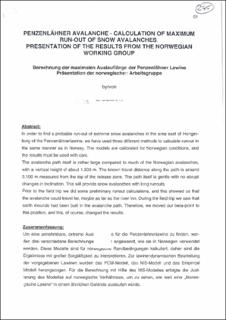| dc.description.abstract | In order to find a probable run-out of extreme snow avalanches in the area east of HU:1gerburg of the Penzenlahnerlawine, we have used three different methods to calculate runout in the same manner as in Norway. The models are calibrated for Norwegian conditions, and the results must be used with care. The avalanche path itself is rather large compared to much of the Norwegian avalanches, with a vertical height of about 1.500 m. The known travel distance along the path is around 3.100 m measured from the top of the release zone. The path itself is gentle with no abrupt changes in inclination. This will provide snow avalanches with long run outs. Prior to the field trip we did some preliminary runout calculations, and this showed us that the avalanche could travel far, may.be as far as the river Inn. During the field trip we saw that earth mounds had been built in the avalanche path. Therefore, we moved our beta-point to this position, and this, of course, changed the results. | en_US |
